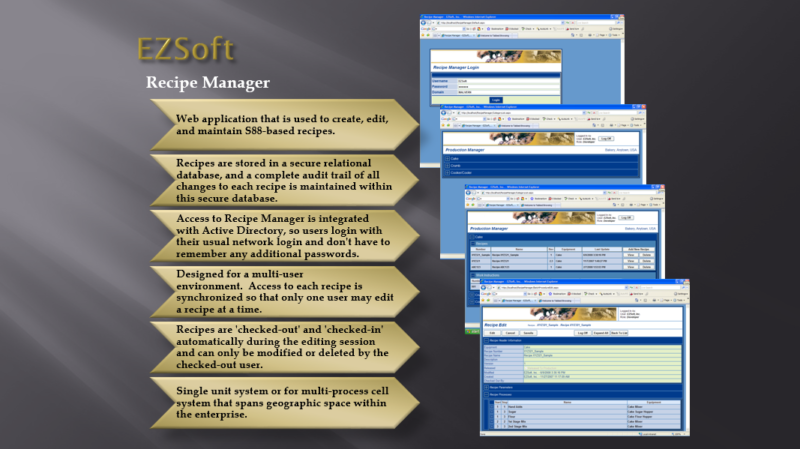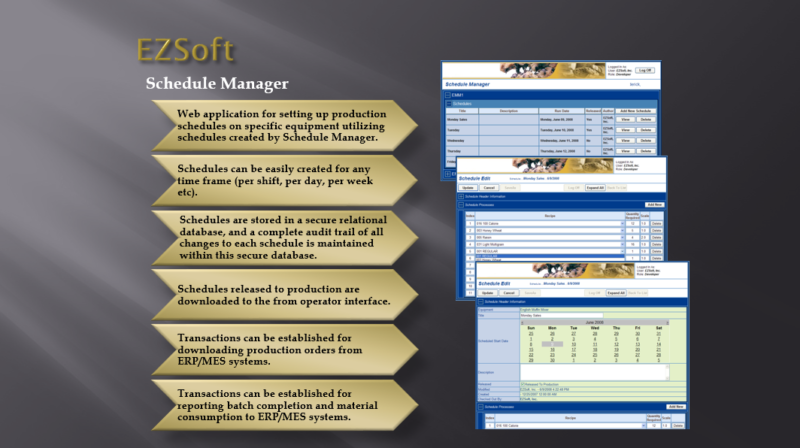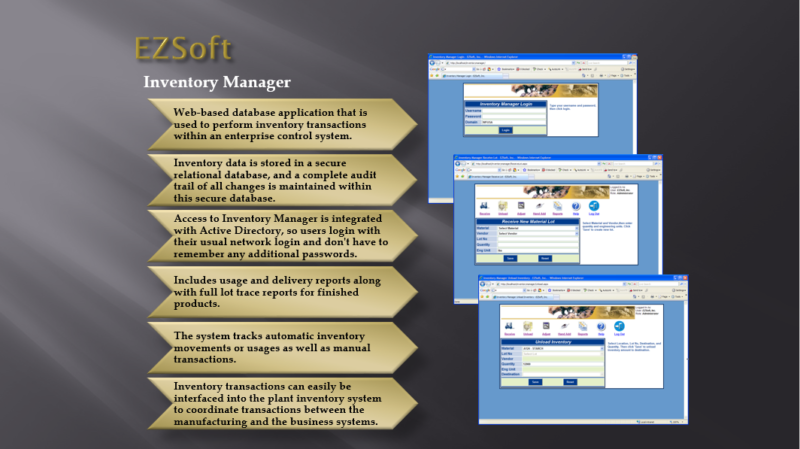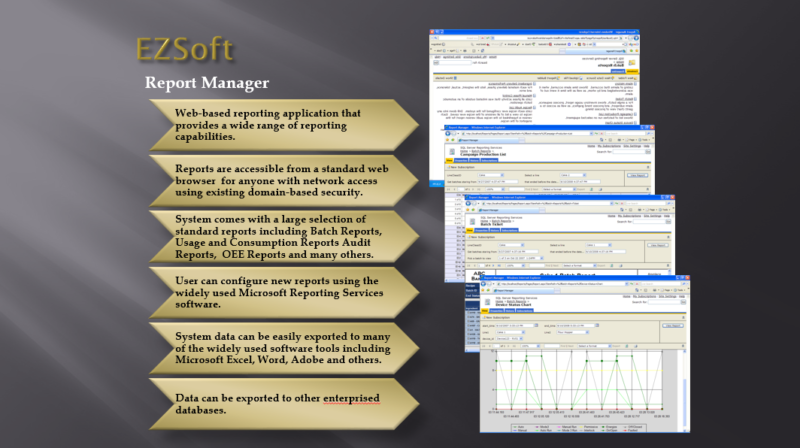Maximize Productivity with EZSoft’s Virtual Production Manager
EZSoft is proposing the installation of their Virtual Production Manager Modules including the use of the following modules: Recipe, Scheduling, Inventory, Shipping, Reporting, Performance, Dashboards. The breakdown would include:
- Recipe Management
- Production Scheduling
- Receiving & Inventory Control
- Production/Efficiency Reporting
- Material Requirement Calculation
- Lot Tracking
- Hand Scaling
- Performance Tracking
- Barcode Reading
- Label Printing
- Finished Goods Handling and Shipping/Sorting
- Dashboards
EZSoft, Inc. Strives for the Following
Provide the highest quality of software integration due to our structured and systematic method of programming
Provide and enforce a standard for system development
Significantly simplify future support of the system
Provides superior documentation
Minimizes risks associated with a new system installation
Significantly reduce the amount of time and costs required to design, program, and install a system
Significantly reduce the amount of time and costs required for integration, testing and startup
Virtual Production Manager Modules
The system will use various modules of our Virtual Production Manager to provide your Production Management with a comprehensive system to manage everything from incoming materials through shipment tracking. The Suite is highly configurable to utilize either a traditional Desktop computer(s) or any handheld floor devices such as phones or tablets. The Suite will include the following:Recipe Manager:
A highly scalable module that is used to create, store and manage S88 based recipes. Recipes are sequences of operations such as material additions, instructions, etc. to create intermediate, bulk, or finished goods products.
Recipe Manager™ provides top-end recipe management for the system. Recipes are stored in a SQL Server database. The recipes are created, modified, and deleted via the Recipe Manager™ module. Recipe Manager™ is a .NET windows application and can be installed as a thick client or accessed via RDP client on any phone, tablet, or PC. The recipe includes header information, formula information, and procedure information and is consistent with the S88 model used at the control level. There is no limit to the number of recipes that can be stored (provided the server hard disk is not full).

Schedule Manager:
A module used to create and manage schedules.
The System shall receive batch run schedules from mainframe via .csv file and shall execute schedule on appropriate reweigh station. System shall receive recipe data (ingredient and quantity) from mainframe via .csv file and download recipe data to appropriate reweigh station. There are screen(s) that allow a user with appropriate credentials to edit a schedule.

Inventory Manager:
A module database application that is used to perform inventory transactions.
Transactions include receiving, adjusting, moving, FIFO Queue modification, scrapping, state change, and shipping.

Report Manager:
Report Manager uses SQL Reporting Services to deliver a broad spectrum of Batch and Production Reports.
Report Manager™ uses Microsoft’s SQL Reporting Services to provide a robust, reliable, and extendable reporting platform for Batch Execution and Inventory Management data. Report Manager™ can be accessed from any client device as well as any networked workstation via web browser.
The top end of the system consists of a Batch/Report Server running a Microsoft SQL database. The database is used as the secure data warehouse to store recipe data, schedule data, and detailed batch data. With the Inventory Manager software, the server will save and report detailed lot tracking and inventory data.
- Current Inventory
- Inventory Receiving History
- Inventory Usage
- Inventory Reverse Genealogy
- Inventory Adjustments
- Inventory Moves
- Inventory Reconciliation
- Lot Expiration
- Batch Report

Lot Tracking & Barcoding:
This module will allow scanning of incoming raw materials (including bar code printing) and allow for Inventory Reconciliation. Receiving personnel would use a mobile handheld device with a barcode scanner with integrated display and scan a shipping label to pull up ingredient on screen. They can also access the application with a standard networked PC in the facility.
If a deviation is found, the operator will be prompted to correct, either by adjusting existing lot quantities, or re-entering the total inventory quantity. This System shall log all manual entry events and all deviation events. Materials can be assigned default bag weights and product ID’s on a per-Vendor basis.
The inventory tracking will allow for the following features:
- Screen(s) to configure ingredients
- Recipe unit of measure
- Order unit of measure
- Cost per unit
- Bag weight
- Pieces per pallet
- Default vendor
- Lead time
- Min/max inventory thresholds
- Ingredient use rate
- Expiration time (shelf life)
- Lots shall be auto quarantined when expiration timer expires
- Capability to be used for non-ingredients: Bags, closures, etc.
- Screen(s) to receive lots into the system
- System will mark each item on the PO as “Received”
- System will generate an internal label per lot received
- Each receiving station (typically one per site) requires a barcode label printer
- Bulk ingredients received into a silo or tank, such as flour, do not require a label, are queued up and consumed FIFO, or a lot can be assigned as the current lot at a location. Lot can also be assigned at consume time on ad-hoc basis.
- Label will be affixed to each pallet of raw material
- System shall have ability to mark a lot as quarantined at any time
- Operator shall have the ability to edit a lot’s details, including adjustment of current quantity
- Operator must be logged in and provide explanation/comment
- Whole lots or partial lots received at one location must be able to be transferred to another location
- Automatic usage of ingredients by lot, when reported by external systems
- Manual usage of ingredients by lot, by operator entry
- System shall have the ability to move lots between locations at a site
Pre-weigh Stations:
This module will support multiple preweigh stations at each line, either with weight transmitter in panel communicating over ethernet or by prompting operator to enter weight data. This module receives schedule and recipe data from the system and displays current recipe, batch ID, current batch number, batches ordered, and batch size. It also displays ingredient list for current recipe, with setpoints.
For ingredient currently being weighed, displays ingredient name, setpoint, and scale weight. Operator is required to scan barcode to capture lot of each ingredient being weighed and the lot is verified after scanning to check expiration, quarantine, and quantity in inventory. (Other scenarios supported include FIFO usage, assigned-lot, or ad-hoc lot entry at consume time). Preweigh station will report ingredient lot and usage data to Virtual Production Manager.
Operator can reset the current batch if there is an issue with the weigh-up and tare an empty bucket if necessary. In the case of a scale or hardware failure, ingredient weigh-ups can be manually acknowledged and will track usage based on the target weight.
To improve efficiency, we recommend the use of deploying new Ethernet communication bench scales to replace as many existing scales as possible. This will allow automatic data collection/verification between the software and the scales. There are several available families of such scales offered. The average cost per scale ranges from around $700-$1,000. EZSoft can quote and supply these upon request.
Advanced Finish Goods Handling & Shipping Sorting:
- Allocate inventory by lot number for order fulfillment
- Capture and validate lot numbers of inventory being put away into inventory
- Capture and validate lot numbers of inventory being moved within the plant, as well as being checked or adjusted (e.g. cycle count or physical inventory tasks)
- Capture and validate lot numbers of inventory being picked for customer shipments
- Verify truck load station for order placement
- Capture QC information (surface temperature) during manufacture
- Generate necessary labelling
- Maintain historical records for finished goods warehousing/shipping
Software Configuration:
This project phase will involve the completion of the screen development and Virtual Production Manager project configuration.
All data and commands shall be accessible by use of a touch-screen or keyboard. Screens shall be designed to allow the user to navigate and command using the touch-screen or keyboard.
The system shall provide an easy to use interface for the operator. Screens can be customized.
Operator Interface Terminals:
Supervisory functions are provided from both terminal(s) and wrist mounted computers located throughout the production, receiving, and shipping areas. The terminals are PC-based, running the Windows operating system and Virtual Production Manager. These stations provide the following capabilities:
- Inventory Receiving, and other Inventory Transactions
- Pre-Weigh / Handscaling at weigh stations for batch operations.
- Batch Manufacturing
- Production Order Tracking
- Shipping
The recommended configuration for wearable production access utilizes Honeywell’s Dolphin 70e Wearable Mobile Computers. These devices are enabled to operate with a Bluetooth ring-mounted barcode reader. In addition, we recommend the use of Zebra Technologies wearable barcode printers.
Scales:
EZSoft recommends the purchase of Ethernet communication scales to maximize the effectiveness of using our software solution. We are offering either the Ohaus Defender 5000 D52 scales or the benchtop Valor scales, both which are equipped with an Ethernet communications port. These scales are both readable by Virtual Production Manager to verify weights and totally eliminate manually entries.
Follow us on facebook
